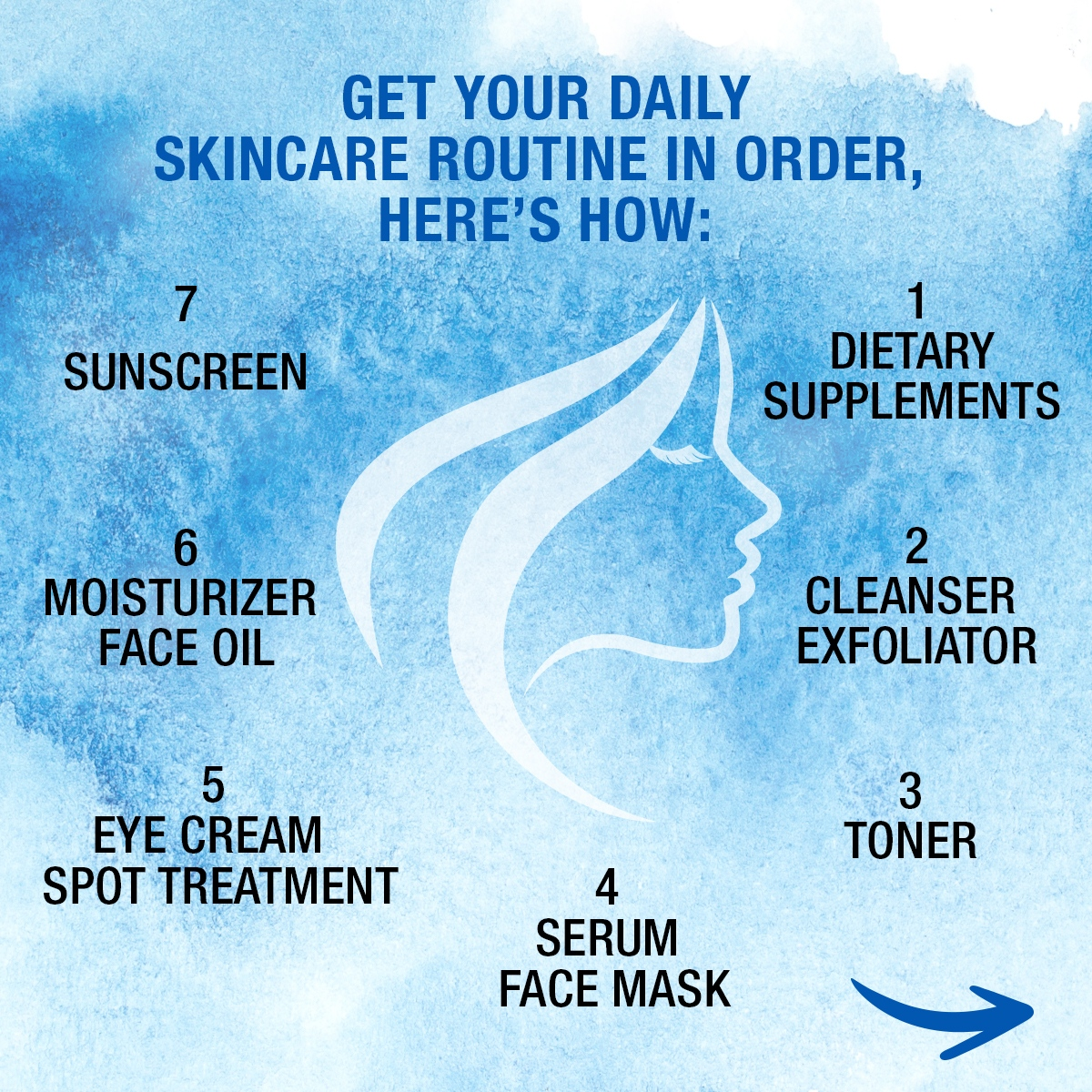
When it comes to getting radiant, healthy-looking skin, the order in which you apply your products is extremely important. Despite this, many people are still unsure of what exactly that order should be. Moisturizer first, then serum? Serum first, then moisturizer? What happens if you apply them “in the wrong order”? We’ll take a look at the best order to apply, reasons why it’s best to use a serum before moisturizer, and tips on how to combine these products for the best results.
Order of application of skincare products
Dermatologists recommend applying products in order from lightest to heaviest. This means that you should start with the thinnest skincare product, wait for it to fully absorb into the skin, and then move on to thicker products. 1 Depending on how many “steps” your skincare routine includes This will look a little different for everyone. But if you use cleanser, toner, and foundation skincare, your routine should look something like this:
Cleanser – washes your face to remove dirt, oil, and impurities.
Toner – balances the pH level of the skin to prepare it for better absorption of subsequent products. (Some people find toners too harsh for sensitive skin. In this case, you can skip this step!)
Serum – Serums deliver concentrated active ingredients deeper into the skin. 2 If you use FS products, use a 20% Vitamin C Lotion during this step. It contains the highest concentration of Vitamin C for brightening, but is thinner than moisturizer, so it should be used first.
Moisturizer – Moisturizer is thicker and provides and locks in moisture. If you use a foundation skincare product, apply a Hyaluronic Acid Lotion immediately. This product is generally well tolerated even for sensitive skin, and should be used afterwards to lock in the benefits of the Vitamin C serum. Allow the serum to absorb for at least a few minutes before applying moisturizer!
Sunscreen – We recommend using a sunscreen with an SPF of at least 30 (or 50 for the face). You should apply sunscreen in the morning to protect your skin from UV rays.
Why should you use a serum before your moisturizer?
Serums typically have a lightweight, fast-absorbing texture and are packed with powerful active ingredients like vitamins, peptides, and antioxidants. Their main function is to penetrate deep into the skin to combat specific issues like fine lines, hyperpigmentation, or dehydration. 2
On the other hand, the purpose of a moisturizer is to form a barrier on the surface of the skin, locking in moisture and preventing it from escaping. 3 If you
apply a serum after a moisturizer, the thicker texture of the moisturizer can create a barrier that prevents the serum from effectively penetrating the skin.
What happens if you apply a moisturizer before a serum?
If you apply a moisturizer before a serum, you may find that the serum doesn’t absorb into the skin as well. Thicker moisturizers create a barrier on the surface of the skin that prevents the serum from being absorbed. As a result, the active ingredients in the serum may not have the effect you want.
In addition to interfering with the absorption of the serum, applying the two products in the “wrong order” may not look good. This is especially important if you’re applying these products in the morning, perhaps under makeup. You want to create a smooth skin surface, but applying moisturizer first and then serum may create a strange texture.
Serum and Moisturizer Ingredients Don’t Mix
Generally, it’s beneficial to use a serum first and then a moisturizer, but there are some ingredients that shouldn’t be mixed to avoid potential side effects. For example:
Retinoids and AHA/BHA: Combining retinoids with alpha hydroxy acids (AHA) or beta hydroxy acids (BHA) increases the risk of irritation and sensitivity because both products strip the outer layer of the skin. If you use Foundation Skincare’s Nightly Renewal Cream (which contains Granactive Retinoid) and also want to use a product with an AHA or BHA, you should alternate between them at night, or use one in the morning and the other at night. 4
Retinoids and Benzoyl Peroxide: Benzoyl peroxide can reduce the effectiveness of retinoids, such as FS Nightly Renewal Cream, which may be affected if used at the same time. There are some exceptions on the market where these ingredients are intentionally combined into a stable formula. 4
Retinoids and Vitamin C: Vitamin C may reduce the effectiveness of retinoid products if layered. Instead, we recommend using FS Nightly Renewal Cream before bed and then FS Vitamin C Lotion in the morning after washing your face. This should help prevent skin irritation or sun sensitivity. 4
Retinoids and Salicylic Acid: These ingredients used together can dry out your skin and cause irritation. Instead, we recommend alternating these products. For example, you could use FS Nightly Renewal Cream one night and a salicylic acid product the next. However, you may not need to use both products at the same time, as retinoids can help treat acne, just as salicylic acid does. 4
Best Serum and Moisturizer Combos
We’ve already briefly discussed how Foundation Skincare’s products can be used together and in what order, but let’s discuss them in more detail. Using the products in this order can strengthen your skin while minimizing the risk of irritation.
Cleanser: The American Academy of Dermatology recommends washing your face with a gentle, non-irritating cleanser morning and night. 5
Niacinamide Lotion (optional): Niacinamide is a B vitamin that has powerful anti-inflammatory properties. When applied to the skin, it increases the production of ceramides and supports the formation of keratin and other important proteins. 6,7 Foundation Skincare’s Niacinamide Lotion is a relatively thin product, so it should be applied like a serum immediately after cleansing.
Vitamin C Lotion 20%: It was once believed that Niacinamide and Vitamin C should not be combined, but this is an excellent combination for the skin when used correctly. Once the Niacinamide Lotion is absorbed, you can follow up with Foundation Skincare’s Vitamin C Lotion. This lotion contains the highest concentration of Vitamin C to brighten your skin and minimize signs of aging. *Nighttime: Instead of using the Vitamin C Lotion for this step, you can use the FS Night Renewal Cream. This product contains 2% Granactive Retinoid and Essential Peptide Growth Factor. These ingredients help reduce fine lines, acne, and skin aging. You can apply this product under or over your moisturizer, depending on how sensitive your skin is. We recommend using retinoids like these at night, as they can make your skin sensitive to the sun, and using Vitamin C products in the morning, as they can help brighten the skin and protect it from environmental toxins. Hyaluronic Acid Lotion: As you may have noticed, Hyaluronic Acid is not mentioned as an ingredient that requires caution when mixing with other ingredients. In fact, most people consider Hyaluronic Acid to be safe and well-tolerated. Foundation Skincare’s Hyaluronic Acid Lotion is extremely gentle and carefully formulated to hydrate your skin – without any “fad” ingredients. This is the thickest product in your foundation skincare routine and should be used second to last in your skincare routine. It can be safely used with all other foundation skincare products.
Azelaic Acid Cream (optional): Azelaic acid is used to treat skin conditions such as acne, rosacea, and hyperpigmentation. If you want to add Foundation Skincare’s Azelaic Acid Cream to your skincare routine, you can safely use it as a final layer in the morning or evening after your moisturizer. This product contains 14% azelaic acid, the highest over-the-counter concentration you can get.
Sunscreen: Don’t forget this important step in your skincare routine before going out. * Evening: Of course, don’t worry about applying sunscreen at night!
If this is too many steps for you, we recommend using at least a Vitamin C serum in the morning, followed by a moisturizer and sunscreen, and a Night Renewal Cream in the evening, followed by a Hyaluronic Acid Lotion.


